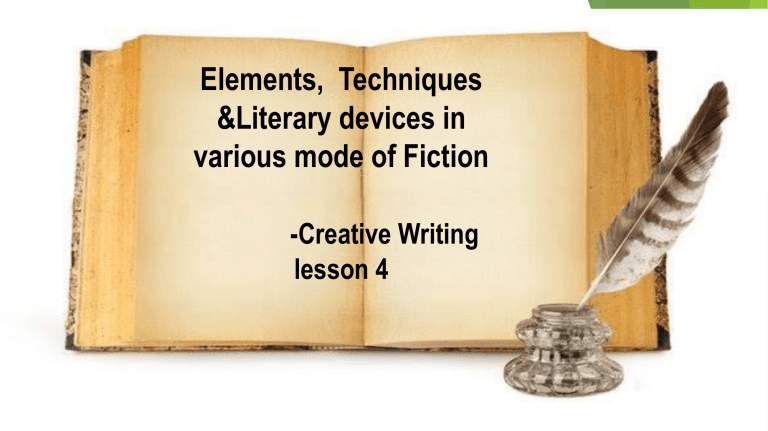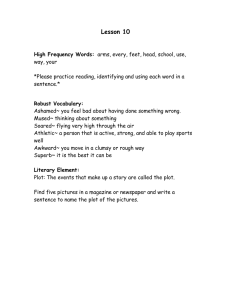
Elements, Techniques &Literary devices in various mode of Fiction -Creative Writing lesson 4 Elements of Fictional Prose Character - people who take part in the story. - Protagonist - Antagonist - Dynamic - Flat -Round - Static Literary device- is a technique that shapes narrative to produce an effect on the reader. Plot device- an object, character or a concept introduced into the story by the author to introduce its plot. a. Flashing arrow- techniques used to focus the reader’s, but not the characters’ attention on an object or location b. Red herring- it is used to maintain tension and uncertainty 3. Deathtrap- device that the villain uses to try to kill the protagonist and satisfy his own desires. 4. Reverse chronology- a technique where the story begins at the end and works back toward the beginning. 5. In medias res’- narrative starts in the middle of the story instead of from the beginning. VISION - character share with the reader visions of the past or the future to explain a character’s motives. 1. Dream sequence- series of dreams which allows the character to see events that occur or have occurred in another time 2. Analepsis (flashback)- prevents events from before the current time frame. Flashbacks are usually presented as characters’ memories and are used to explain their background. Example: Titanic. The story used Rose, the main character, to tell the events happened to Titanic. 3. Prolepsis (flash-forward)- presents events that will occur in the future. Example: Final Destination seeing what will happen in the future. 4. Prophecy- is often used in science fiction to underline their futuristic structures. 5. Foreshadowing- is a premonition, muck like a flash-forward, but only hints at the future. 1. 2. ENDING - refers to story endings Cliff-hanger- an abrupt ending that leaves the plot incomplete, without denouement, it often leaves characters in a precarious or difficult situation which hint at the possibility of a sequel. Films with sequel are examples of this. Twist ending- is an unexpected finale that gives an entirely new vision on the entire plot. It is a powerful technique but may leave the reader dissatisfied and frustrated. 1. 1. Happy ending- a finale when everything ends in the best way for the hero. Example: Since the target audience are the children, Disney Movies have Happy endings. Deus ex machina- plot dating back to ancient Greek theater, where the conflict is resolve through a means (god, or dues) that seem unrelated to the story. This allows the author to end the story as desired without following the logic and continuity of the story. Assessment Identifying Time! Directions: Read the story “The Last Leaf” by O’ Henry with understanding and appreciation. Using the outline below, identify the elements, literary devices and techniques used by the writer of the story. Write your answers on your answer sheet. Characters (Consider the kinds of characters) Setting (Consider the elements of setting) Plot (Identify the five parts of a plot) Theme, Tone, Subject, Motif Conflict and Point of View vi. Plot Device, Vision and Finale used in the story I. II. III. IV. V.


